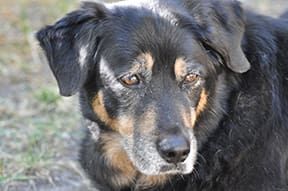I stayed with some of my best friends recently, a family whose sons are close to my son, and whose dog Carly has been a part of WDJ since her adoption as an adolescent some 13-plus years ago. Carly has been used as a model for WDJ only sporadically for two reasons: she’s mostly black, which doesn’t always show well in print; and she’s never been all that crazy about the camera – she yawns and looks away a lot (two signs of mild anxiety) when the camera is trained on her.

288
Despite not being seen in the magazine much, Carly has been the inspiration for many articles in WDJ. Carly had separation anxiety for about a year after she was adopted, and would dig under the fence, chew shingles off the side of the house ( !!! ), and engage in many other acts of destruction in order to find some relief for her anxiousness when home alone. I asked Training Editor Pat Miller for a couple of articles about separation anxiety during this time, in order to help my friends come up with tactics for helping Carly.
We also had a feature about how to teach your kids to train the family dog. That article was really all about teaching Carly’s highly active twin 9-year-old boys to train her properly, with clear, quiet cues and ample rewards when she did the right thing.
Another time, I wrote an editorial about how annoying it can be when you don’t take your own advice. In the pages of WDJ, we always caution people not to leave a dog unsupervised with toys or chews – and once, when I was dog-sitting Carly and I got distracted by a long phone call, I realized that the backyard was dotted with stuffing from the toy she had been playing with earlier — but I couldn’t find the main body of the toy, a sizeable piece of fabric. Shamefaced, I had to tell my best friends that I would be responsible for paying for any needed surgery, if it developed that Carly had actually eaten the toy and it caused intestinal trouble. (Carly was fine – and I found the toy MONTHS later, buried under one of my rose bushes.)
There have been many more articles inspired by Carly – although, right now, I’m sharing others that are already in our catalog with her owners to help her now, such as the ones on finding ways to get a dog who has lost her appetite to eat (“Tales of the Lost Appetite,” March 2008), and assistive devices to help a dog who has lost mobility (March and August 2011). Carly is at least 14 years old now, and in decline. Some days, she won’t eat at all, or she’ll take just a few bites of the chicken that the mom has cooked just for her. She is still determined to sleep upstairs in her house as she’s always done – but having a really hard time with the stairs, so the family has to take turns supporting her every time she goes up or down (and they had to bring out a gate again, not needed since her adolescence, to prevent her from attempting the climb when no one is home to help, so she doesn’t have a fatal fall). Really, the care she’s getting now is hospice care – and as the articles in our April 2006 and March 2010 issues made clear, it’s hard to provide, physically and emotionally. On Carly’s bad days, her eyes show no interest in what’s going on around her and she doesn’t want to eat (and I’m thinking about whether or not I should send my friends “Making Peace With Death,” January 2002). But then she’ll suddenly perk up and chow down, and greet every family member coming in the front door with shiny eyes and a slow-wagging tail like always, and even look for one of her favorite toys to chew or squeak.
There is no single correct way to decide how to spend a dog’s final days – with one exception: Heaping love, praise, touch, time, food, and attention on the deserving dog is always appropriate. That my friends are doing in spades, and I was privileged to share in some of that myself. I wish much love upon them all. Good dog, Carly.






